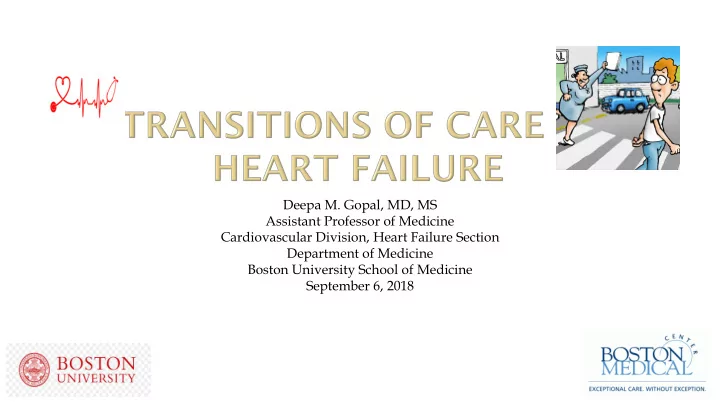

Deepa M. Gopal, MD, MS Assistant Professor of Medicine Cardiovascular Division, Heart Failure Section Department of Medicine Boston University School of Medicine September 6, 2018
NHANES data 2011- 2014 estimated 6.5 million Americans (≥ 20 years of age) had heart failure (HF) – which was an increase from 5.7 million estimation based on 2009-2011 data Projections show prevalence of HF will increase 46% from 2012 to 2030 resulting in > 8 million people over the age of 18 with HF AHA Statistics on Heart Disease and Stroke, Circulation 2018
First acute decompensated HF event rates per 1000 (ARIC Community Prevalence of HF in adults Surveillance (2005-2014) (NHANES: 2011-2014) AHA Statistics on Heart Disease and Stroke, Circulation 2018
• Elderly are major players in HF hospitalizations and with aging population these are significant contributors HF risk doubles in the in individuals with a BMI of ≥ 30 kg/m 2 • compared to BMI < 25 kg/m 2 ; obesity prevalence now 39.6% from NHANES data 2015-2016. Racial disparities continue to confer to elevated HF risks (particularly among African Americans and Hispanic individuals) In community cohort studies, 55% of symptomatic HF was with preserved ejection fraction – which to date has no current disease- modifying therapy
• In 2009, Centers for Medicare and Medicaid Services (CMS) began confidentially reporting readmission rates; under the ACA, the Hospital Readmission Reduction Program (HRRP) 2012 – hospitals are financially penalized if they have higher than expected risk- standardized 30-day readmission rates for HF • The majority of hospitals receiving penalties are large hospitals, teaching hospitals, and safety-net hospitals. • While the metrics themselves are often called into question, hospitals are investing time and resources into transitional care management (TCM) strategies (CMS additionally provided CPT codes for TCM in addition to payment for chronic care management services)
The rate of HF hospitalizations (National Center for Health • Statistics) and VA data suggest NO changes in HF hospitalizations over 1-decade period Fee-for-service Medicare claims used from 2006-2008, the 30-day • all-cause risk standardized re-hospitalization rate was 24.7% Post-discharge hospital service utilization in increasing (17% in • 2000 to 21% in 2010) without impact on HF readmission Hall etal, NCHS Data Brief, 2012; Shah etal, Circ HF 2011; Chen etal, Am J Med 2012
Circulation 2015
Current issues in HF care – opportunities for TOC
AHA statement identified 13 studies that evaluated features and • outcomes of HF rehospitalization rates following a disease management program Intervention time: 10 days - 3 months • Outcome measures: many were 30 days readmissions, some 90d, • 180 Results: Majority of studies were able to show reduction in 30-day • readmission, however, these reductions were consistently reduced at longer follow-up time periods Limitations: most notably, small sample sizes (n<350 per arm), • several quasi-experimental/retrospective (n=6 studies); only 5 enrolled HF exclusively
Intervention providers Nurses (APNs); interdisciplinary Patient education* Patient-centric approach (teaching tools, teach-back methods) Telephone follow-up Discuss/manage symptoms, recognize early complications, address questions, verify medications Early follow-up visit after 7-10 days after HF admission discharge Medications Recommended at admission, immediately before discharge in some programs; adding pharmacist* Caregivers Evaluation of caregiver support and education Home visits Usually reinforces patient education, help patient make self — care decisions Handoff to post-hospital Hospital summary, discharge plans, medication changes, items to be addressed for follow-up visit providers
• TCM calls by Cardiology clinic RN in 24-48 hours Post-discharge • Specialist follow-ups • Identification and modification for risk factors for readmission • EPIC note to cardiologist/PCP Discharge • 7-10 days (with HF provider) • 21-30 day (with PCP) • Teaching by CMP NPs • General Cardiology service HF admission • CCU service • HF consult team
Brief summary of hospitalizations Identified modifiable factors to decrease readmission risk with specific details of how such factors were dealt with inpatient and what needs to be done as outpatient Admission/discharge weights Discharge vitals Effective diuretic dose in hospital Medication changes – specifics on CV medication discontinuations/dose reductions Itemized list of outpatient duties: lab checks, up-titration of medications, device interrogations, outpatient consultations
Significant predictors of readmissions on analysis of BMC HF • patients Prior readmissions* Chronic kidney disease Stage 2 or greater Patients with cancelled or no-shows to their 7-10 day HF follow-up Homelessness Psychiatric disorder BMC – HF Readmission committee meeting comprised of • multidisciplinary group (BMC clinicians – geriatrics, NP, Cardiology, QI, Strategy) working to developing tailored approaches for our population
Pharmacy collaboration on the inpatient side – medication • reconciliation prior to discharge, meds-to-bed, blister-packing for core HF medications (with diuretic outside) Index HF admission – identification of modifiable • contributing factors (medication non-adherence, poor health literacy, education, behavioral/dietary indiscretions, co- morbidities – including substance abuse and psychiatric disorders, home insecurity)
Closer collaboration with PCP and specialists of key co- • morbidities (renal, pulmonary, substance abuse) Development of outpatient palliative care transitions – • identified when inpatient Improvement of the metrics: better comparison • hospitals/models, HF-specific readmissions, understanding of the competing risks, higher rates may reflect higher disease severity rather than quality of care provided
Recommend
More recommend